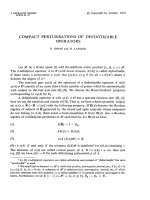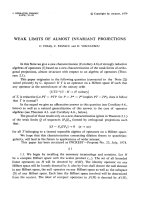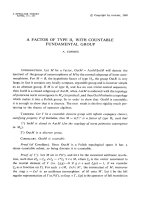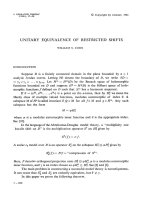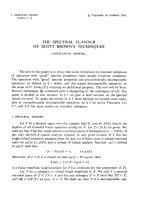Báo cáo toán học: "List edge-colorings of series-parallel graphs" potx
Bạn đang xem bản rút gọn của tài liệu. Xem và tải ngay bản đầy đủ của tài liệu tại đây (106.21 KB, 6 trang )
List edge-colorings of series-parallel graphs
Martin Juvan
∗
Department of Mathematics, University of Ljubljana
1111 Ljubljana, Slovenia
Bojan Mohar
∗
Department of Mathematics, University of Ljubljana
1111 Ljubljana, Slovenia
Robin Thomas
†
School of Mathematics, Georgia Institute of Technology
Atlanta, GA, 30332
Abstract
It is proved that for every integer k ≥ 3, for every (simple) series-parallel
graph G with maximum degree at most k, and for every collection (L(e):e∈
E(G)) of sets, each of size at least k, there exists a proper edge-coloring of G
such that for every edge e ∈ E(G), the color of e belongs to L(e).
Submitted: February 25, 1999; Accepted: September 17, 1999.
Mathematical Subject Classification: 05C15.
1 Introduction
List colorings are a generalization of usual colorings that recently attracted consider-
able attention, cf. [1, 8, 9, 11]. Originally, list colorings were introduced by Vizing [12]
∗
Supported in part by the Ministry of Science and Technology of Slovenia, Research Project
J1-0502-0101-98. Part of the work was done while the author was visiting Georgia Institute of
Technology.
†
Partially supported by NSF under Grant No. DMS-9623031 and by NSA under Grant
No. MDA904-98-1-0517.
1
the electronic journal of combinatorics 6 (1999), #R42 2
and Erd˝os, Rubin, and Taylor [6] in the seventies. The definition of a list edge-coloring
is as follows. Let G be a multigraph. An edge-list assignment L: E(G) →P(N)isa
function that assigns to each edge e of G aset(oralist) L(e)ofadmissible colors.
A function λ: E(G) → N is an L-edge-coloring if λ(e) ∈ L(e) for every e ∈ E(G),
and λ(e) = λ(f) for every pair of adjacent edges e, f ∈ E(G). A graph G is k-
edge-choosable if it has an L-edge-coloring for every edge-list assignment L such that
|L(e)|≥kfor each e ∈ E(G).
Our work is motivated by the following conjecture, which apparently first appeared
in [3], but was considered by many other researchers (see [8, Problem 12.20]).
Conjecture 1.1 Every graph G is k-edge-choosable, where k is the chromatic index
of G.
Conjecture 1.1 holds for bipartite multigraphs by a result of Galvin [7], for 3-
regular planar graphs as noticed by Jaeger and Tarsi (unpublished), and for d-regular
d-edge-colorable planar multigraphs by a result of Ellingham and Goddyn [5].
Conjecture 1.1 is regarded as very difficult. For instance, even the special case
of complete bipartite graphs K
n,n
, formerly known as Dinitz’ conjecture, was open
from 1978 until Galvin’s result mentioned above. In light of that it seems reasonable
to study special classes of graphs, in the hope of either finding a counterexample, or
gaining more insight. The purpose of this paper is to show that Conjecture 1.1 holds
for series-parallel graphs, thus eliminating one natural class of possible counterex-
amples. The proof can be used to design a linear time algorithm to list-edge color
series-parallel graphs.
2 Two lemmas
Agraphisseries-parallel if it has no subgraph isomorphic to a subdivision of K
4
.It
is well-known [4] that every (simple) series-parallel graph has a vertex of degree at
most two.
Lemma 2.1 Every non-null series-parallel graph G has one of the following:
(a) a vertex of degree at most one,
(b) two distinct vertices of degree two with the same neighbors,
(c) two distinct vertices u, v and two not necessarily distinct vertices w, z ∈ V (G)\{u, v}
such that the neighbors of v are u and w, and every neighbor of u is equal to v,
w,orz,or
(d) five distinct vertices v
1
,v
2
,u
1
,u
2
,w such that the neighbors of w are u
1
,u
2
,v
1
,v
2
,
and for i =1,2the neighbors of v
i
are w and u
i
.
the electronic journal of combinatorics 6 (1999), #R42 3
Proof. We proceed by induction on the number of vertices. Let G be a non-null
series-parallel graph, and assume that the result holds for all graphs on fewer vertices.
We may assume that G does not satisfy (a), (b), or (c). Thus G has no two adjacent
vertices of degree two. By suppressing all vertices of degree two (that is, contracting
one of the incident edges) we obtain a series-parallel multigraph without vertices of
degree two or less. Therefore, this multigraph is not simple. Since G does not satisfy
(b), this implies that G has a vertex of degree two that belongs to a cycle of length
three. Let G
be obtained from G by deleting all vertices of degree two that belong
to a cycle of length three. First notice that if G
has a vertex of degree less than two,
then the result holds for G (cases (a), (b), or case (c) with w = z). Similarly, if G
has a vertex of degree two that does not have degree two in G, then the result holds
(one of the cases (b)–(d) occurs). Thus we may assume that G
has minimum degree
at least two, and every vertex of degree two in G
has degree two in G. By induction,
(b), (c), or (d) holds for G
, but it is easy to see that then one of (b), (c), or (d) holds
for G.
When case (d) of Lemma 2.1 occurs, the graph from Figure 1 has to be colored.
The existence of an appropriate coloring is guaranteed by the following lemma.
2
v
1
u
1
22
44
w
2
v
2
u
2
Figure 1: A special graph with the numbers of remaining colors.
Lemma 2.2 Let G be the graph from Figure 1 and let L be an edge-list assignment
for G such that |L(e)|≥2if e is incident with u
1
or u
2
, and |L(e)|≥4otherwise.
Then G admits an L-edge-coloring.
Proof. Suppose first that there is a color c ∈ L(v
1
u
1
) ∩ L(u
2
w). Color v
1
u
1
, u
2
w
by c and u
1
w, v
2
u
2
arbitrarily. Since v
1
w retains at least two admissible colors, the
coloring can be extended to G. So, assume that L(v
1
u
1
) ∩ L(u
2
w)=∅. Suppose now
that there is a color c ∈ L(u
1
w) such that |L(v
1
u
1
)\{c}| ≥ 2. Color u
1
w by c and
u
2
w, v
2
u
2
arbitrarily. Since v
1
u
1
still has at least 2 admissible colors, we can choose
the color for v
1
u
1
such that v
1
w and v
2
w are left with distinct admissible colors. By
symmetry, the remaining case is L(v
1
u
1
)=L(u
1
w), L(u
2
w)=L(v
2
u
2
), and hence
L(u
1
w) ∩ L(u
2
w)=∅. In this case it is easy to check that at least three of the four
L-colorings of v
1
u
1
, u
1
w, u
2
w, v
2
u
2
can be extended to G.
the electronic journal of combinatorics 6 (1999), #R42 4
3 List edge-colorings of series-parallel graphs
The following theorem is the main result of the paper.
Theorem 3.1 Let k ≥ 3 be an integer, and let G be a series-parallel graph with
maximum degree at most k. Then G is k-edge-choosable.
Proof. We proceed by induction on |V (G)| + |E(G)|. The theorem clearly holds
for the null graph, and so let G be a series-parallel graph with at least one vertex,
and let L be an edge-list assignment with |L(e)|≥kfor every edge e ∈ E(G). By
Lemma 2.1 one of (a)–(d) of that lemma holds. If (a) holds, then the theorem follows
by induction applied to the graph G − v,wherevis a vertex of G of degree at most
one. Assume next that (b) holds, and let u
1
, u
3
be two vertices of degree two in G
with the same neighbors, say u
2
and u
4
.Then{u
1
,u
2
,u
3
,u
4
} is the vertex-set of a
4-cycle C in G.LetG
be obtained from G by deleting the edges of C.ThenG
has an L-edge-coloring by the induction hypothesis, and this L-edge-coloring can be
extended to an L-edge-coloring of G, because every edge of C is incident with at most
k − 2edgesofG
.
If (d) of Lemma 2.1 holds, then let G
be the graph obtained from G by deleting the
vertices v
1
, v
2
,andw.ThenG
has an L-edge-coloring by the induction hypothesis,
and this L-edge-coloring extends to an L-edge-coloring of G by Lemma 2.2.
Thus we may assume that (c) of Lemma 2.1 holds, and let u, v, w, z be as in that
condition. If G has an edge e with both ends of degree two, then the theorem holds
by the induction hypothesis applied to the graph G − e, because e is incident with
at most two edges of G − e. Thus we may assume that w has degree at least three,
and that u has degree exactly three. Hence the neighbors of u are v, w,andz,where
z=w.
If L(vw)∩L(uv) has at most one element, or if k>3, then every L-edge-coloring of
G −v extends to an L-edge-coloring of G, as is easily seen. Thus we may assume that
L(vw)∩L(uv) has at least two elements, and that k =3.Letz
be the neighbor of w
other than v and u.LetS,α,andβbe such that |S| =2,α, β ∈ S, S ∪{α}⊆L(vw),
S ∪{β}⊆L(vu), and let G
be the graph obtained from G − v by contracting the
edge uw.Ifα=β,orα∈ L(wz
), or β ∈ L(uz), then every L-edge-coloring of G
extends to an L-edge-coloring of G.SinceG
has at least one L-edge-coloring by the
induction hypothesis, we deduce that the theorem holds.
We may therefore assume that α = β, α ∈ L(wz
), and β ∈ L(uz). We claim that
G−v −uw has an L-edge-coloring λ such that either λ(wz
) = α,orλ(uz) = β.Ifz=
z
, then this follows from the induction hypothesis applied to G −v −u −w,andsowe
may assume that z = z
.Letγbe a new color that does not appear in any of the lists,
and let L
be the edge-list assignment of G
defined by L
(wz
)=(L(wz
)\{α})∪{γ},
L
(uz)=(L(uz)\{β}) ∪{γ},andL
(e)=L(e) for all other edges e ∈ E(G
). The
graph G
has an L
-edge-coloring by the induction hypothesis. If the color of the
edge wz
is γ, we change it to a color from L(wz
) that is distinct from the colors of
the electronic journal of combinatorics 6 (1999), #R42 5
the (at most two) edges of G − v − uw incident with wz
, and we proceed similarly
if the color of the edge uz is γ. This way we obtain the desired L-edge-coloring λ of
G − v − uw. Such an L-edge-coloring extends to an L-edge-coloring of G, as desired.
It has been suggested that Conjecture 1.1 might hold for multigraphs as well.
However, our proof works only for simple graphs; the corresponding problem for
multigraphs seems to be much harder. For a multigraph G let
Γ(G)=max
2|E(G[U])|
|U|−1
U ⊆V(G),|U|≥3and|U|odd
.
Seymour [10] proved that if G is a series-parallel multigraph, and k is an integer with
∆(G) ≤ k and Γ(G) ≤ k,thenGis k-edge-colorable. If conjecture 1.1 holds for
multigraphs, then G is in fact k-edge-choosable, but we were unable to prove that.
The methods of this paper can be used to prove a slightly stronger result: Let G
be a series-parallel multigraph such that each vertex v has at most one neighbor which
is joined to v by more than one edge. If k ≥ max{∆(G), 3},andLis an edge-list
assignment for G such that |L(e)|≥kfor every edge e ∈ E(G)and|L(e)|≥k+1
for every edge e ∈ E(G) that is parallel to another edge of G,thenGhas an L-edge-
coloring.
The proof of Theorem 3.1 can be converted to a linear-time algorithm, as follows.
Let G be a graph. We say that a vertex v
1
∈ V (G)isspecial if one of the following
conditions holds:
(a) the degree of v
1
is at most one,
(b) the vertex v
1
has degree two, and it has the same neighbors as some other vertex
of degree two,
(c) there exist vertices u ∈ V (G)\{v
1
} and w, z ∈ V (G)\{u, v
1
} such that the
neighbors of v
1
are u and w, and every neighbor of u is equal to v
1
, w,orz,or
(d) there exist four distinct vertices v
2
,u
1
,u
2
,w ∈V(G)\{v
1
} such that the neigh-
bors of w are u
1
,u
2
,v
1
,v
2
,andfori=1,2 the neighbors of v
i
are w and u
i
.
Thus Lemma 2.1 implies that every series-parallel graph has a special vertex.
Now let G be a series-parallel graph on n vertices with maximum degree ∆. Given
a vertex v ∈ V (G), we can test in time O(∆) whether v is special. In particular, all
special vertices can be found in time O(∆n). The proof of Theorem 3.1 can be
converted into a recursive procedure. By maintaining a stack of all special vertices,
we can find a set of vertices as in Lemma 2.1 in constant time at each step. Using
those vertices, we adjust the graph accordingly (following the cases in the proof of
Theorem 3.1), update the stack, and apply the algorithm recursively to the smaller
graph. This can be done in time O(∆). The resulting coloring can be converted into
a coloring of the original graph in time O(∆). Overall, this gives:
the electronic journal of combinatorics 6 (1999), #R42 6
Proposition 3.2 There is an algorithm that given a series-parallel graph G on n
vertices with maximum degree ∆ and an edge-list assignment L such that |L(e)|≥∆
for all e ∈ E(G) finds an L-edge-coloring of G in time O(∆n).
Let us remark that the total size of the lists is at least ∆n, and so our algorithm
is indeed linear in the size of the input. A linear time algorithm for ordinary edge-
colorings of series-parallel multigraphs is described in [13].
References
[1] N. Alon, Restricted colorings of graphs, in “Surveys in combinatorics,” Cam-
bridge Univ. Press, Cambridge, 1993, pp. 1–33.
[2] N. Alon, M. Tarsi, Colorings and orientations of graphs, Combinatorica 12
(1992) 125–134.
[3] B. Bollob´as,A.J.Harris,List colorings of graphs, Graphs and Combinatorics
1 (1985), 115–127.
[4] J. Duffin, Topology of series-parallel networks, J. Math. Anal. Appl. 10 (1965)
303–318.
[5] M. N. Ellingham, L. Goddyn, List edge colourings of some 1-factorable multi-
graphs, Combinatorica 16 (1996) 343–352.
[6] P. Erd˝os, A. L. Rubin, H. Taylor, Choosability in graphs, Congr. Numer. 26
(1980) 125–157.
[7] F. Galvin, The list chromatic index of a bipartite multigraph, J. Combin. The-
ory Ser. B 63 (1995) 153–158.
[8]T.R.Jensen,B.Toft,Graph Coloring Problems, Wiley, New York, 1995.
[9] J. Kratochvil, Z. Tuza, M. Voigt, New trends in the theory of graph colorings:
Choosability and list coloring, preprint, 1998.
[10] P. D. Seymour, Colouring series-parallel graphs, Combinatorica 10 (1990) 379–
392.
[11] Z. Tuza, Graph colorings with local constraints – a survey, Discuss. Math.
Graph Theory 17 (1997) 161–228.
[12] V. G. Vizing, Coloring the vertices of a graph in prescribed colors (in Russian),
Diskret. Anal. 29 (1976) 3–10.
[13] X. Zhou, H. Suzuki, T. Nishizeki, A linear algorithm for edge-coloring series-
parallel multigraphs, J. Algorithms 20 (1996) 174–201.


